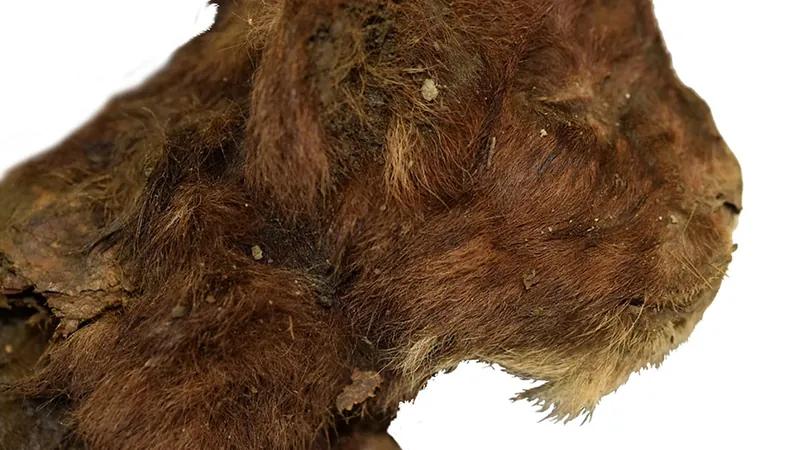
Unveiling the Mystery: The World’s First Saber-Toothed Cat Mummy Discovered in Siberia
2024-11-19
Author: Li
Introduction
For nearly 200 years, the enigmatic appearances of saber-toothed cats have baffled paleontologists. Despite various artistic representations in museums and their portrayal in popular culture, such as the Ice Age films, the true look of these formidable predators remained largely speculative. Recent findings, however, have cast new light on this ancient feline, revealing the appearance of a saber-toothed cub that lived approximately 32,000 years ago in the Siberian permafrost.
“I was over-the-moon excited to see such an incredible specimen,” exclaimed Ashley Reynolds, a paleontologist at the Canadian Museum of Nature, who was not involved in the research. The Siberian landscape is renowned for being a treasure trove of mummified remains, predominantly of herbivores, with apex predators like saber-toothed cats being a rare find.
The Discovery
The remarkable discovery was made in 2020 when diggers searching for mammoth tusks stumbled upon the frozen carcass, as noted by A.V. Lopatin, a paleontologist at the Russian Academy of Sciences. He and his team were 'surprised and delighted' to study this unique specimen, which they detailed in the journal Scientific Reports on November 14.
About the Saber-Toothed Cat
This frozen cub, identified as a baby Homotherium latidens, is unlike any other mammal of its time. Known as the scimitar-toothed cat—distinguished by its shorter, serrated fangs compared to the 'dirk-toothed' Smilodon—the Homotherium was a long-limbed predator adept at pursuing prey rather than relying on ambush techniques like its famous counterparts. Its diet likely included juvenile mammoths and other megafauna prevalent during the Ice Age, with fossil evidence suggesting that these predators sometimes created dens to rear their young.
Speculation and Findings
Before this discovery, paleontologists could only speculate about the appearance of Homotherium, relying on fossilized bones lacking soft tissue details. Illustrators often depicted saber-toothed cats with visible canines protruding from their mouths; however, a recent study suggested that Homotherium may have had deep muzzles with concealed sabers hidden beneath the upper lip.
New Insights
The uncovered cub’s unique features have raised further questions about these prehistoric creatures. With its lip structure being more than twice as deep as that of a modern lion cub, some researchers theorize that adult Homotherium may have also possessed lips capable of concealing their impressive fangs. Nonetheless, because the cub has not yet developed its adult teeth, further discoveries of adult mummies are needed to answer these lingering mysteries.
Anatomical Surprises
The anatomy of the cub also reveals surprising similarities to adult Homotherium. According to paleontologist Margaret Lewis, the juvenile exhibited enlarged neck muscles and strong forelimbs, indicating that it was well-adapted to its predatory lifestyle from a young age. Furthermore, the structure of its jaws suggests the capability of wide gapes, essential for delivering powerful bites into prey.
Fur Coloration
Another captivating aspect of this find involves the cub's fur coloration. In the natural world, coat colors in modern cats often correlate with their habitat. However, the deep brown coat of this particular cub has taken experts by surprise. Lopatin noted that much like cave lions, which were also found preserved in the permafrost, Homotherium cubs may have had darker fur that lightened as they matured.
Absence of Patterns
Adding to the intrigue, researchers found the absence of spotting or striping patterns typically common in modern feline species. There's a possibility that the current reddish tint of the cub’s fur is due to its preservation conditions rather than its natural coloration. Future genetic analysis may shed light on the actual hues these ancient predators showcased during their lifetime.
Future Research
Experts anticipate continued research on this remarkable specimen, as it provides invaluable insights into an Ice Age mammal with no contemporary equivalent. Homotherium and other saber-toothed cats specialized in hunting the megafauna of their era but eventually succumbed to extinction as changing climates and human activities decimated their prey population. The soft tissue details found in this cub bring comprehensive understanding to a narrative previously constructed from incomplete fossil records, underscoring the importance of such discoveries in the ongoing effort to understand prehistoric life.
Conclusion
For those fascinated by the prehistoric world and its magnificent creatures, the discovery of the world’s first saber-toothed cat mummy opens the door to countless possibilities and deeper understanding of the Ice Age fauna. Don’t miss out on what this finding could unveil about one of history’s most fearsome predators!



 Brasil (PT)
Brasil (PT)
 Canada (EN)
Canada (EN)
 Chile (ES)
Chile (ES)
 España (ES)
España (ES)
 France (FR)
France (FR)
 Hong Kong (EN)
Hong Kong (EN)
 Italia (IT)
Italia (IT)
 日本 (JA)
日本 (JA)
 Magyarország (HU)
Magyarország (HU)
 Norge (NO)
Norge (NO)
 Polska (PL)
Polska (PL)
 Schweiz (DE)
Schweiz (DE)
 Singapore (EN)
Singapore (EN)
 Sverige (SV)
Sverige (SV)
 Suomi (FI)
Suomi (FI)
 Türkiye (TR)
Türkiye (TR)